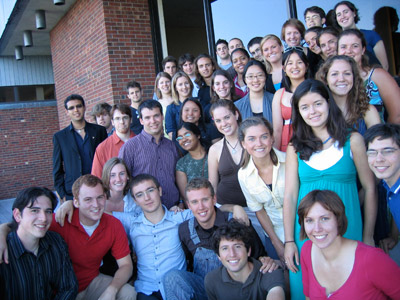STEM Education & America’s Future
Many believe science, technology, engineering and math (STEM) are the foundation for future economic growth, national security and a sustainable environment for the United States. The U.S. is still a world leader in undergraduate and graduate STEM education. However, STEM education and training must be broadened to include not only those interested in earning higher degrees but also those with a high school education who must be sufficiently trained to benefit from future employment opportunities in STEM fields.
The Woods Hole Oceanographic Institution (WHOI) is a leader in STEM research and education for the ocean environment. Its best known education program, and an example of an excellent STEM graduate education program, is the partnership with the Massachusetts Institute of Technology (MIT) for the MIT/WHOI Joint Program in Oceanography/Applied Ocean Science and Engineering.
During the upcoming academic year, the program will award its 900th M.S. and Ph.D. degree. And, its graduates are in research and education leadership positions in academia, industry, government and the military. As with many other STEM graduate programs in the U.S., the MIT/WHOI program recruits and graduates both U.S. citizens and foreign nationals. Program experience demonstrates that top U.S. college graduates compete well in graduate school with top students from India, China, Europe, Russia and other countries. This attests to the excellent STEM education provided by many U.S. undergraduate institutions – at least for the top students who major in STEM fields.
There are, however, some interesting differences between U.S. and foreign undergraduates. For example, Russian students arrive with a superb background in mathematics, particularly theory, whereas U.S. undergraduates are, perhaps, initially stronger in problem-solving skills. The MIT/WHOI program began in 1968 with an all-male student body, and changes in the gender balance have been an interesting trend throughout the years. Recruiting is now gender-blind. For at least the past decade, the gender balance has been close to 50:50 men and women – a trend seen in many other STEM fields. Recruiting minorities into graduate programs in ocean science and engineering, however, is still a challenge.
In addition, U.S. immigration laws are a hurdle for retaining top foreign nationals beyond their postdoctoral training. (It is common for those receiving a Ph.D. to acquire additional postdoctoral training and experience for one year or more before seeking a permanent job). Many foreign nationals receive their Ph.D. degrees at U.S. research universities and institutions at U.S. taxpayer expense. Therefore, regulations should be eased to make it less difficult to retain those who wish to remain in the U.S. and contribute their skills to the national economy.
Programs for STEM Competency
The National Science Foundation (NSF) and other Federal agencies support summer programs for undergraduate STEM majors. The NSF summer Research Experience for Undergraduate (REU) programs, and similar programs sponsored by other agencies, are hosted by U.S. universities and research institutions in many STEM fields. The REU program at WHOI involves 30 undergraduate students each summer – primarily rising seniors – interested in STEM fields focused on the ocean environment. The 10– to 12-week summer program at WHOI is typical of other REU programs around the country in that participants spend most of their time working with scientists and graduate students on a research project.

Fig. 1 – Photo Credit: WHOI
Their summer culminates in an oral presentation and written report describing the summer research. In many instances, the written report leads to a manuscript in a scientific journal, and the oral presentation leads to a poster or oral presentation at a national scientific meeting. Thus, the REU experience exposes undergraduates to real research experience.
Students learn how to define a problem, how to collect and analyze the necessary data, and how to present the results orally and in written form. Some also experience initial failure along the way and learn how to overcome it to complete a project – an important lesson for a budding scientist or engineer. The REU programs stimulate and prepare students for graduate work in STEM fields. Figure 1 is a picture of the undergraduate participants in a recent summer REU program at WHOI. Even from a casual examination of the photo it would be difficult to accept the stereotype, still believed by some, that top undergraduate science and engineering majors are “nerds.” It is even more difficult to accept that stereotype when one learns of the diverse outside interests of these excellent STEM students, which range from music and art to theatre, mountain climbing and sports.
United States military academies recognize the increasing importance of STEM competency. They emphasize STEM education for their future officers who will have to master the sophisticated, high-tech equipment now in use throughout the U.S. military and to train others in its use. For example, the required courses to graduate from the U.S. Military Academy (USMA) at West Point include two semesters each of chemistry, physics and calculus plus probability and statistics. And, these core classes are taken before a cadet chooses a major, which will include additional courses in such fields as photonics, robotics, electronics, geospatial information and other STEM fields. The USMA also recognizes the benefits of hands-on research and encourages cadets to spend a few weeks in the summer on internships at research institutions around the country, as well as a capstone research project during their final year at West Point.
The message in the preceding paragraphs is that many U.S. undergraduate and graduate institutions are world-class and are providing many high quality STEM majors. This important characteristic of U.S. higher education is threatened by cuts to the budgets of Federal agencies supporting scientific and engineering research. Such cuts, or even level funding if sustained for many years, could seriously threaten higher STEM education at U.S. institutions for the future.
Gaps in High-School STEM Education
Nevertheless, the most serious gap in STEM competency in the U.S., for at least the near future, is probably not at the undergraduate or graduate level but rather for those who stop their education with only a high school degree or with limited post high school training. It is simply not possible for those who have earned STEM-field higher education degrees to fill all the jobs that require technical skills and STEM competency. The United States must sustain the high quality of its STEM undergraduate and graduate education programs. Additionally, STEM education and training in the U.S. must improve for those who do not pursue a higher degree.
Many recent articles in business and other magazines highlight the problem of STEM competency in the U.S. A recent article in Atlantic magazine reported an analysis of math performance of top secondary school students from around the world and for each of the U.S. States. Test scores for top performing students were chosen to better provide an apples-to-apples comparison since significant differences exist among the testing pool between countries and between states within the U.S. The study results showed that top-performing Massachusetts students were the only students from the 50 U.S. states whose math test scores were in the ballpark with high-performing students from many other countries, such as Finland, Taiwan and Japan.

© iStockphoto.com/danleap
Why do secondary school students in Massachusetts outperform those from other states? In brief, 10 years ago Massachusetts began demanding meaningful outcomes from everyone in the school system by making it harder to become a secondary school teacher, making students pass a test before graduating and by moving State funding around to schools where it is most needed. The Atlantic and other such articles point to the need for national programs like “Teach for America,” which focus on student outcomes, and “City Year,” which puts young core members into failing secondary schools as tutors and mentors to try to raise school performance.
An Inadequately Trained U.S. Workforce
Articles in business magazines point out that the U.S. is currently experiencing a manufacturing boom. In spite of current high U.S. unemployment, however, many manufacturing companies cannot fill current job openings. Why? Manufacturing in the U.S. is now high-tech and requires workers who can operate, maintain and repair sophisticated computer-driven machinery, including industrial robots. Many high school graduates lack basic knowledge in STEM fields and are thus deemed unqualified for training programs, which U.S. companies are willing to provide to teach new employees how to operate sophisticated machinery.
Rising labor costs overseas are making U.S. manufacturing more competitive. Thus, manufacturing jobs for qualified U.S. workers should increase in the future. But, will the U.S. be able to fill these jobs with those who are currently unemployed? Certainly not if budget cuts lead to summer closures and course cutbacks at community colleges, which are now so critical for STEM training, such as occurred in California during the past year. The U.S. military is also concerned about the STEM competency of enlisted personnel and are willing to fund programs addressing this need.
The U.S. faces many future challenges, which will require solutions that must come from STEM fields and by those with STEM competency at all education levels. For example, many opportunities in the general area of sustainability will require solutions based on the world’s best science and engineering. Many believe the companies and nations that develop these technologies will lead the world into a new economy.
To name just a few areas, the U.S. needs to improve its capabilities to harvest wind and solar energy, and to scrub and effectively store CO2 emitted by burning hydrocarbon fuels. It will also be a an engineering challenge to meet the 50 mpg target recently set for new car fleets in the U.S. by 2025. The recent release of oil in the Gulf of Mexico demonstrates that ocean scientists and engineers need to develop safer and better ways to drill for and pump gas and oil from offshore platforms, and to monitor the impact of those operations on the environment. Sophisticated ocean observing systems based on networks of sophisticated sensors could meet the latter challenge. Operating, maintaining and repairing those systems will require people with the same type of STEM training that are being sought for manufacturing jobs.
President Obama reminded Congress last year that “the countries that out-teach us today will out-compete us tomorrow.” Those involved with STEM education at all levels, from primary to secondary to undergraduate to graduate schools, need to work together to help lead the U.S. into the STEM-based future of the world.

© iStockphoto.com/enot-poloskun





























